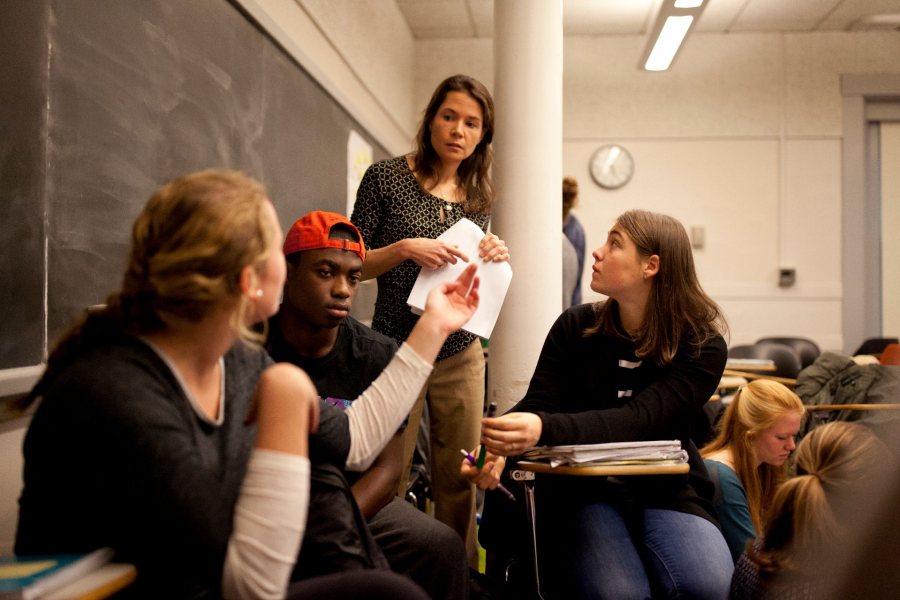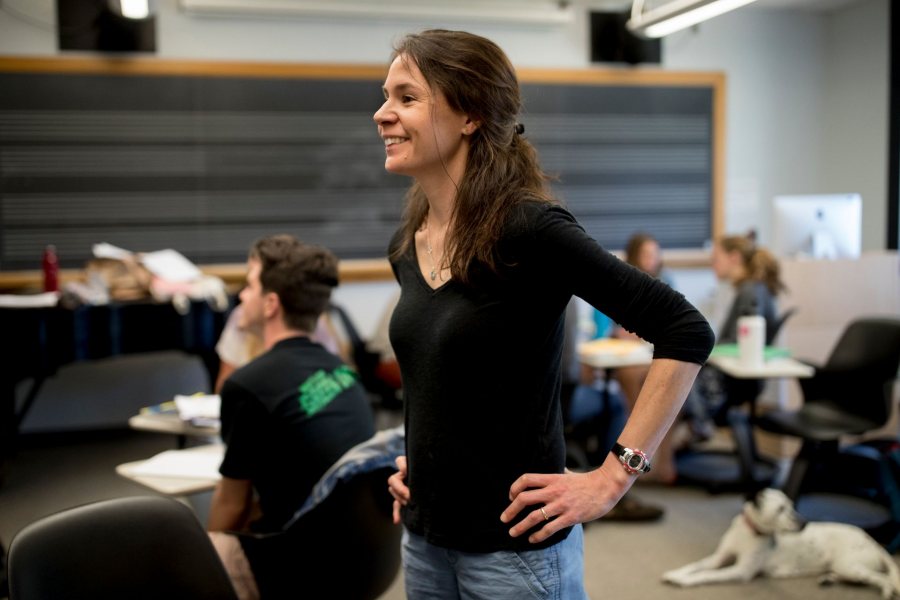
What happens when a middle-school student’s classes have moved online due to the coronavirus — but her rural community doesn’t have high-speed internet? What if her family can’t afford the breakfast and lunch she and her siblings normally get at school? And what happens to the accommodations she usually gets for deafness, or dyslexia?
Travis Palmer ’21 is one of the people trying to answer these questions in his western Maine community. A school board member in a district that comprises his hometown of Rumford and several smaller towns and communities, he’s had a front-row seat to decisions about feeding students, remote learning, and long-term planning.
Palmer, who has been on the board for four years, has also been talking to and learning from Associate Professor of Education Mara Tieken, an expert on rural education who is closely watching how rural teachers and school districts across the country are rethinking, often in a matter of days, their entire approach to education.

Over the past several weeks, Tieken has heard from a variety of educators, from administrators of big Texas school districts to college advisors who serve public and semi-private schools in Maine, about what’s working for them and what they need in a new era of remote learning. She’s also helped create a rural community resource hub for school administrators.
The answers she got paint a picture of educators doing their best in uncharted waters — teachers moving instruction online, administrators distributing food and technology. She hopes that the stories she has gathered will help shed light on the issues these communities face and help direct resources to the schools and districts most in need.
“In the long term, I would like to help think about what we can take away from this experience and how we can change our educational system based on what we’ve learned,” Tieken says.
Perhaps the most pressing problem facing rural school districts around the country is food. During the school year, many students rely on breakfast and lunch provided by schools free or at reduced prices, and educators have to figure out how to continue to distribute those meals. (For students who are homeless or transient, the challenge grows exponentially more difficult.)
It’s a little easier for urban and suburban school districts to set up convenient meal pickups at places around a city. It’s harder for rural schools, which might serve families across a vast geographic area and whose families still might not have transportation.

Palmer says school administrators in his district, Regional School Unit 10, have set up meal pickup points, distributing hundreds of meals a day, as close to families’ homes as possible. “Ideally, we’re trying to get out to the places where people are, because it’s difficult to expect parents to have the time or transportation to get the kids to these places,” Palmer says.
Tieken has heard from other districts that are using school buses to deliver meals, or asking paraprofessionals like classroom assistants to do so. The schools still have to navigate legal issues — what does an ed tech’s union contract allow him to do? — plus ever-evolving stay-at-home orders and practical concerns like refrigeration. Still, “that flexibility is great,” Tieken says.
Keeping students fed is a concern for any school district, rural or urban, that serves poor families. But rural schools in particular have to be creative about technology, Tieken says. Many families don’t have the devices they need for the kids to do schoolwork, and access to high-speed broadband internet varies by race, income, and location. In 2019, only 63% of rural adults were broadband users.
“The terrain can make it more difficult for signals to reach farther,” Tieken says.
Access to technology varies within Palmer’s own district, he says. Districts in other states have had to scramble to distribute tablets or laptops, but Maine has long been a leader in so-called one-to-one technology, and RSU10 has already purchased Chromebooks for most students. In the towns in Palmer’s district, up to 90% of families have access to broadband.
“This problem is so frustrating because it’s so fixable, and we knew it.”
Palmer is happy with the way these students and their teachers have transitioned to remote learning.
But some pockets of his district don’t even have cell service, let alone high-speed internet. Families there receive lesson plans via paper “storm packets,” a holdover from snow days. The packets, Palmer says, are focused more on retaining old material than learning something new, since students don’t have as much contact with their teachers and can’t necessarily rely on their parents to teach them.
“It’s an imperfect system,” Palmer says. “If this blows through, in the next school year we’ve got a lot of catching up to do.”
Other districts around the country are trying different solutions. Tieken heard from one in Texas that wants to set up strategic internet hotspots, though demand for them has made them scarce. Some districts have resorted to asking families to come to the parking lots of schools or local businesses to tap into their Wi-Fi from the car, Tieken says.
“This problem is so frustrating because it’s so fixable, and we knew it,” she says. “There’s been a persistent rural-urban digital divide, so it should surprise nobody.”

Food and technology access directly affects how well students learn, Tieken says — if you’re hungry or anxious about the future, or your laptop dies, you’re not going to be thinking about math or reading as much. But even when schools and districts can provide food and educational technology, the quality of delivery of these resources will vary from district to district and state to state.
Tieken has talked to educators working in many locations and in all kinds of environments, from private schools to large public districts with thousands of students to small districts with a single school. No one setup is better than the other, she says. Some, it seems, are dropping the ball in terms of revamping their curriculum and making sure everyone has the technology they need.
Others, however, are full speed ahead. “I’ve seen some pretty amazing things happening in terms of districts making sure all their kids have technology,” she says. “Teachers are providing synchronous instruction that helps students structure their days, and they’ve got some really cool, innovative lesson plans or videos that are up on the internet.”
As it turns out, each type of school or district has advantages and disadvantages, Tieken found. A smaller district might be better able to distribute devices and be more supportive of teachers, but a bigger district with more resources and people could ensure that thousands of students get the same educational experience.
“This idea of centralized control versus local control, small and nimble versus big and consistent — it will be interesting, the lessons we learn,” she says. But COVID-19 is “not going to equalize things,” Tieken says. Instead it will only exacerbate existing differences.
“If this blows through in the next school year we’ve got a lot of catching up to do.”
This is especially true when it comes to helping students go to college, Tieken says. Rural students were already less likely to earn a college degree than urban or suburban students. And across the board, COVID-19 is changing how high schoolers are choosing a college to attend.
Organizations like Upward Bound, a federal program that since 1965 has helped low-income, first-generation, and rural students gain access to college, have traditionally operated within school buildings, forming relationships with students to help them see college as a possibility, then helping them get there.
“They can pull a kid from a class and say, ‘We’ve got an admissions representative coming from this particular school, and I think it would be a great fit for you,’” Tieken says. “You can’t do that in the same way in this remote environment, build that same kind of trust.”
For Tieken and the educators she’s talking to, other questions abound. What about rural students of color, particularly East Asians and Asian Americans, who are facing increased racism amid the pandemic and might as a result become more isolated? What happens to the diner that serves Friday night sports fans? How will the pandemic affect the school budget long-term? How do you provide special education services?

Those last two are particularly concerning to Palmer in Rumford. A quarter of students in this district receive special education services, which the district is committed (and required by law) to continue to provide. Meanwhile, the 13 members of the school board are trying to pass a budget, made all the harder by the knowledge that many families have lost jobs and are struggling to pay basic bills, let alone an increased property tax to fund the schools.
Many of the educators Tieken has spoken with “are grateful for the light this is shedding on inequities they encounter on a regular basis,” she says.
Now the question is, how and when will the light shine on some solutions, too?


